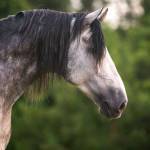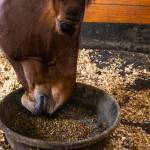Bump Up Bloom with Proper Nutrition, Care

Do vibrant dapples dance on your bay horse’s coat in seemingly three-dimensional glory; does sunlight ricochet from your chestnut’s coppery coat?
As the largest, most visible organ system of the body, the skin in combination with the coat, speaks to the overall health of the horse. Key requirements to supple skin and a glistening coat include a nutritionally balanced diet, appropriate deworming, routine veterinary care including core vaccinations, and frequent grooming and visual inspection.
Systemic disease can negatively affect a horse’s coat. Pituitary pars intermedia dysfunction (PPID, Cushing’s disease) provides a great example, as abnormal shedding and hair growth patterns commonly occur in affected horses and ponies. Young horses with heavy internal parasite burdens frequently have dull, dry coats, as do horses suffering from gastric ulcers.
If no underlying medical condition can be identified to explain a dull, lifeless coat or dry, scaly skin, closely examine your horse’s diet. Is the energy in the diet balanced for the work asked of your horse? Are all important vitamins and minerals being delivered in appropriate quantities?
A comprehensive ration evaluation may seem daunting as professional equine nutritionists will ask many questions and require specific information about your horse’s diet. (Read: find a scale to weigh hay and feed. Few nutritionists are keen on cryptic units of measure, like “scoops” and “flakes,” as these measures can vary considerably.) The information derived from a consultation, however, can completely transform a horse, especially one that’s been missing out on optimal nutrition over the course of many months or years.
If a thorough diet evaluation yields no deficiencies in core nutrients, supplementation may help horses. Adding fat to the diet is one way to increase the quality of skin and coat. Supplemental fat is typically top-dressed to diets through vegetable oil (canola or soy) or stabilized rice bran. Because fat is rich in calories, you will want to work with the nutritionist to ensure the energy level of any diet is suitable for the horse, given its workload or life stage.
Aside from a balanced diet and supplemental fat, other nutrients are thought to be critical in skin and coat health, including biotin, methionine (an amino acid), iodine, zinc, and marine-derived omega-3 fatty acids. Choose high-quality supplements that contain these ingredients. Aside from a research-proven hoof and coat supplement, such as Bio-Bloom HF, consider Hemabuild, a concentrated blend of organic iron, copper, and B vitamins.
In the summer months, biting insects can cause trauma to a horse’s skin or be irritating enough to cause itching. Trauma to the skin occurs when the horse rubs its body on stationary items to relieve the itch.
Further, any sort of bite or environmental allergen, such as pollen or grass, can precipitate an allergic reaction, causing the horse to break out in hives—small, raised regions of the skin. While often self-resolving, hives can be so severe they require veterinary intervention.
Appropriate environmental control includes reducing manure and standing water where insect larvae hatch. Topical insect control in the form of insect repellents as well as fly sheets and masks will also help diminish skin trauma and help maintain coat’s integrity.








